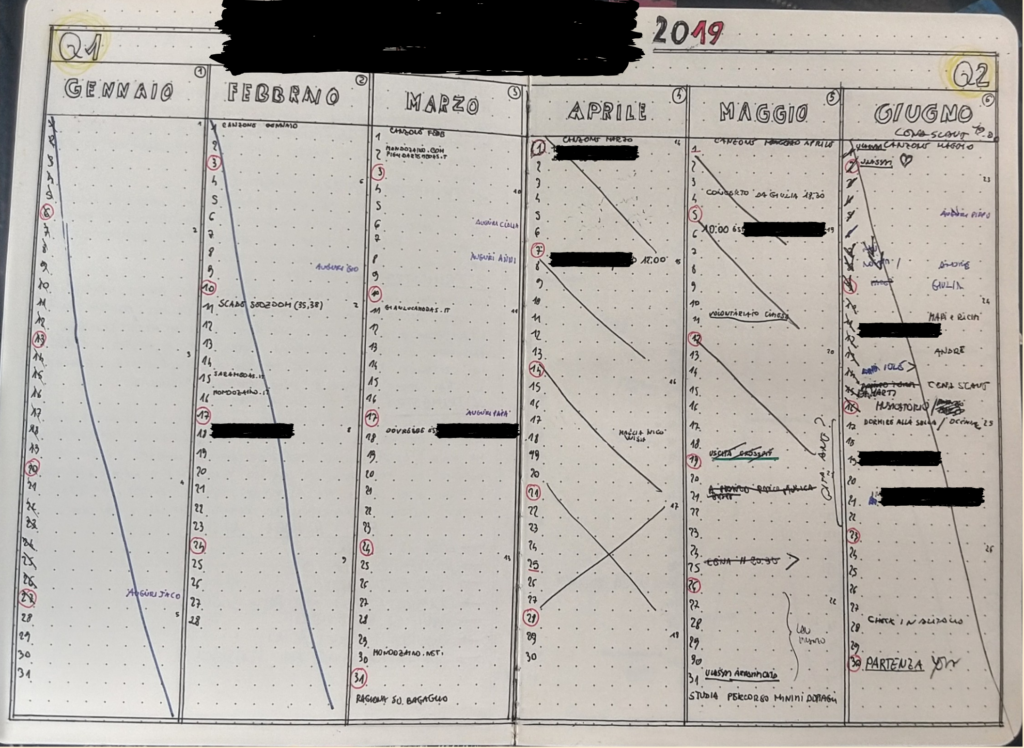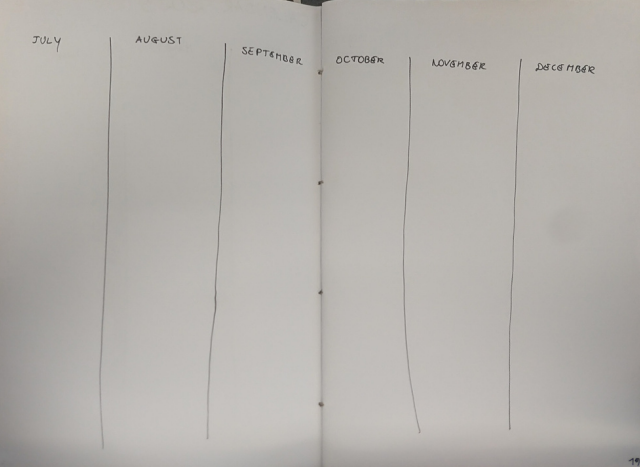
Journaling starter Kit
for Beginners.
Chapter 2

Chapter 2:
Core Essentials for Journaling Now
Let’s start with what you need:
- a notebook;
- a pen.

That’s all.
Of course, having a journal with nice paper, a beautiful design, and a stylish cover gives you a different feeling, but in reality, it’s not necessary at all.
Any inexpensive notebook will do the job. Plus, if you are going to use a 50-cent notebook, when you finish it, you can buy another one of the same size, glue them together, and keep going as long as you like.
Let’s now talk about what the essential elements for journaling Now are:
- Index;
- Year Calendar;
- Purpose.
- Day-to-Day Management
These are the elements I’ve identified to distinguish a simple diary from my journaling practice. But this is just the starting point.
Index
The index is an ancient system, it is simple but extremely effective.
Thanks to the index, you don’t have to worry about leafing through page by page to find “that important reflection”, “that event”, “that note”.

Index: How to use it.
- At the beginning of your journal dedicate a page or two to the Index, you don’t need to number the index pages.
- When you write or jot down something really important, you should write it in the Index. That way it’s not lost forever.
- In the index you will also write the Pages of the Month and all the special pages that you decide to include in your journal.
Key tip: Numbering the pages.
In order to insert the pages in the index you have to number your pages. But don’t worry, you don’t have to number 200 or 300 pages all at once.
This can be done in different ways. You can simply number the first ten, and do ten at a time when you pick up your journal, or number the pages as you write them. Recently, not having much time (and also because it’s a tedious task for me too), I’ve started numbering only the odd pages, if I write page 33 I can know where 32 is even if I haven’t written the number.
Year Calendar
For the journaling Now Method, the Year calendar is essential. Remember when earlier I talked about the metaphor of the map? That feeling of “not knowing where you are” is often closely related to your relationship with your relationship with time.
Our perception of time is linear. While there are several interesting theories about whether this is true or not, we don’t need to worry about that. What matters is that, in Western culture, time is viewed as linear. And if it’s mentally represented as a line, it can also be used as a way to orient yourself.
We have a point A (which comes first) and a point B (which comes after); and we perceive them temporally.
Additionally, depending on the purpose you want to focus your journal on, the calendar can be extremely useful for organizing your goals.
Year Calendar: How to use it:
- A simple Year Calendar is added after the index.
It includes the month and days in vertical columns. This can be done by taking up the back and front of 2 pages. (See pic below). - If you don’t have time to hand write your calendar, don’t worry I created some printable, you can simply print and glue it. If you can’t print it, keep reading, I suggest a Super-fast version of it.
- Write birthdays, deadlines, anniversaries, everything you want to remember in your calendar, gradually write appointments and commitments during the year.
- You can decide to embellish it or not, to use special calligraphy or not, you can use a ruler to make it neater or you can do it all freehand. Simple or decorated, it doesn’t matter—what’s important is that you have one.
- All printable pages are at the end of this guide.



Super-fast version of the Year Calendar.
In case you don’t have the time to write the full Year Calendar by hand, or you don’t have the possibility to print the calendar that I have included at the end of this guide, you can opt for this time-saving version of the Calendar shown in the following picture.
Leave it blank and add dates/appointments as needed. If you are using the fast version of the Year Calendar do not worry about entering the dates/appointments in chronological order.


The Purpose
The most important and final Essential of your journal, is the “Purpose”.
The Purpose can be related to:
- Creative Expression;
- Emotional Release,
- Productivity or organization;
- Tracking habits;
- Monitoring or improving mental or physical health;
- Family management;
- Self-Reflection and Personal Growth.
These are just a few examples, whatever the purpose, a journal is a tool that helps you and accompanies you on the journey from point A to point B.
The difference between a journal and a pre-made planner is that the first allows you to add/create specific pages for any area/project you want, and also gives you space for deeper reflection.
So, let’s find out the purpose of your journal/journaling!
But remember the promise:
“I will NOT demand perfection, from Myself, from my journal and from my Life!”
Don’t expect to understand the purpose of Life, don’t expect to get a Buddha-worthy answer. It’s about understanding “why” you want to use the journal.
There’s no right answer, and there’s no definitive answer.
If you only give a partial answer, that’s okay. You can decide to come back to it later, when you have already started your journal. The purpose may come to you later.
Someone could start the journal with the simple intention of changing a habit, and end up managing a business project. Someone else could start the journal by deciding to organize a business project and end up using the journal mainly as a safe place to use their creativity.
But right now, why do you want to use the journal?
Write today date and answer one or both of the following questions:
- Why do I want to write in my journal?
- What do I expect from my journaling practice?
If thinking about a purpose for your journal sparks absolutely no answers, try to think in different terms.
- What goal/goals do I want to achieve?
It can be one or more than one. Write freely, a little, a lot, one word, 5 pages. Write in good or bad handwriting, draw, scribble some symbols, whatever in the purpose page.
The important thing is to answer the question in a way that you can understand, reread in moments of confusion and remember the reasons that prompted you to start.
Note: There’s a difference between purpose and goals. Purpose is a long-term projection, while a goal is specific and determined. There’s no need to delve too deeply into this at this stage, but I will cover the topic in an in-depth article.
For now, I simply want to help you clarify the reason why you want to start using journaling and identify your Point B that you want to reach.
It doesn’t have to be perfect but just a start.

KEY TIP:
- After answering, leave a page or two in case you want to repeat this exercise later.
- If you have written a lot, at the end summarize your motivations and objectives in a list. If you have written little, try anyway to turn everything into a summary list of your motivations.
- The list may not yet outline clear “objectives”, but you can jot down expectations, aspirations.
- Leave a page or some space in case you want to answer those questions again.
- You can answer those questions directly in the journal, even if you haven’t started compiling anything yet. Asnwer at the very beginning of your Journal or you can leave just 1 page (front and back) for your index, two (front and back) for the Year Calendar or just start the journal with the Purpose page.
Now that we’ve covered the essential components of the journal, it’s time to move on to how to manage your essential practice day by day.
Chapter 2:
After discussing the core of your journal, let’s take a look at how to use it in your daily life!
I’ll see you in the next chapter.
And remember, you can leave me a comment with your questions.

Sign up for the newsletter.
Stay updated on new articles and initiatives from Journaling Now.
